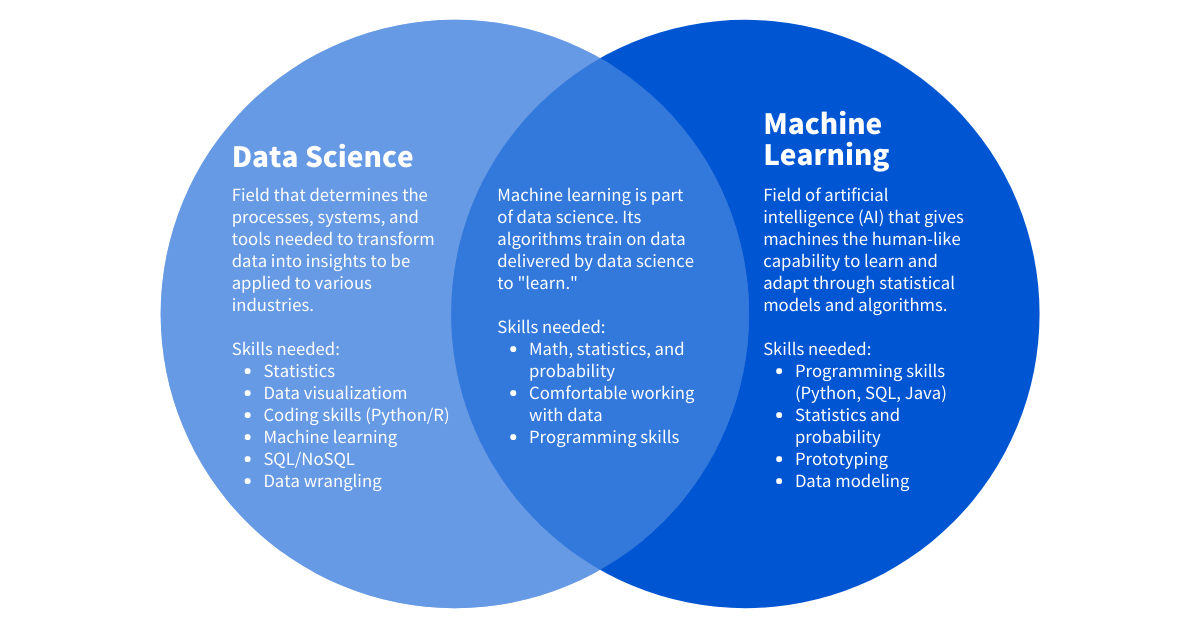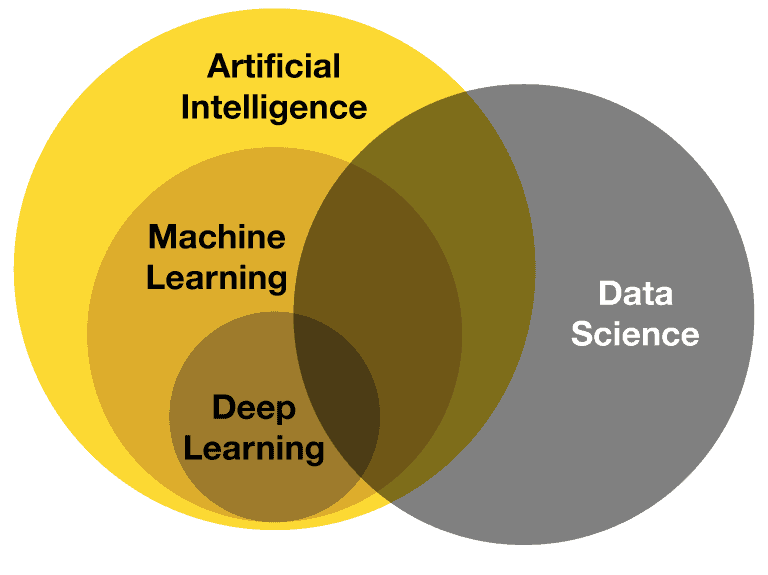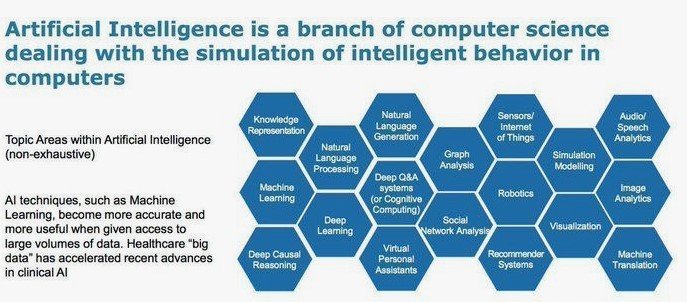Data Science focuses on extracting insights from data. Artificial Intelligence (AI) and Machine Learning (ML) enable systems to learn and make decisions.
Data science, AI, and machine learning are interconnected fields shaping today’s technology landscape. Data science combines statistical analysis and computational techniques to interpret complex datasets. AI aims to create systems that can perform tasks requiring human intelligence, such as speech recognition and decision-making.
Within AI, machine learning provides algorithms that allow systems to learn from data patterns and improve over time. Together, these disciplines drive innovations across various sectors, including healthcare, finance, and marketing. Understanding their synergy is essential for leveraging their full potential in solving real-world problems. Embracing these technologies can lead to enhanced efficiency and smarter decision-making processes.
Table of Contents
Data Science Essentials
Data Science, Artificial Intelligence (AI), and Machine Learning (ML) are exciting fields. They help us make sense of huge amounts of data. Data Science Essentials include key concepts and tools that power these technologies. Understanding these basics can help anyone interested in this dynamic area.
Key Concepts
Key concepts are the building blocks of data science. Here are some essential terms:
- Data: Information collected for analysis.
- Algorithms: Step-by-step procedures to solve problems.
- Models: Mathematical representations of data.
- Statistics: The study of data collection and analysis.
- Big Data: Extremely large data sets that require advanced tools to process.
Understanding these concepts is crucial. They help in data analysis and decision-making. Here’s a simple table summarizing the concepts:
| Concept | Description |
|---|---|
| Data | Raw facts and figures for analysis. |
| Algorithms | Methods to process data and find solutions. |
| Models | Frameworks to predict outcomes based on data. |
| Statistics | Mathematical analysis of data sets. |
| Big Data | Massive datasets requiring specialized tools. |
Tools And Technologies
Tools and technologies are essential for data science. They help in processing and analyzing data. Some popular tools include:
- Python: A programming language for data analysis.
- R: Another programming language focused on statistics.
- Tableau: A tool for data visualization.
- Apache Spark: A framework for big data processing.
- Jupyter Notebook: An interactive tool for coding and sharing results.
Many of these tools are user-friendly. They allow users to explore data easily. Here’s a brief overview of some tools:
| Tool | Purpose |
|---|---|
| Python | General-purpose programming for data analysis. |
| R | Statistical computing and graphics. |
| Tableau | Data visualization for insights. |
| Apache Spark | Fast data processing for big data. |
| Jupyter Notebook | Interactive coding and sharing. |

Artificial Intelligence Basics
Artificial Intelligence (AI) is a fascinating field that focuses on creating machines that can think and learn like humans. It is part of a larger area called Data Science and Machine Learning. Understanding AI basics helps us see how these technologies shape our world. AI can solve problems, make decisions, and even understand language. This blog will explore the history of AI and the different types it includes.
History And Evolution
The journey of Artificial Intelligence began in the mid-20th century. Researchers wanted to create machines that could mimic human intelligence. Here are some key milestones:
- 1950: Alan Turing proposed the Turing Test to check if machines can think.
- 1956: The term “Artificial Intelligence” was coined at a conference in Dartmouth.
- 1960s: Early AI programs like ELIZA began to show promise in natural language processing.
- 1980s: AI saw a resurgence with expert systems that could make decisions in specific fields.
- 2000s: Machine learning techniques became popular, allowing computers to learn from data.
- 2010s: Deep learning emerged, leading to significant advancements in image and speech recognition.
The evolution of AI can be summarized in the table below:
| Year | Milestone |
|---|---|
| 1950 | Alan Turing proposes the Turing Test. |
| 1956 | The term “Artificial Intelligence” is born. |
| 1960s | Introduction of early AI programs like ELIZA. |
| 1980s | Resurgence with expert systems. |
| 2000s | Popularity of machine learning techniques. |
| 2010s | Deep learning advancements. |
This history shows how AI has grown from simple ideas to complex technologies. Each step has brought us closer to creating intelligent machines.
Types Of Ai
Artificial Intelligence can be categorized in various ways. Here are the main types:
- Narrow AI: Specialized in one task. Examples include voice assistants like Siri and Alexa.
- General AI: Can perform any intellectual task like a human. This type is still theoretical.
- Superintelligent AI: Surpasses human intelligence. This type is also a concept for now.
Let’s break down these types further:
- Narrow AI
- Examples: Chatbots, recommendation systems, image recognition software.
- Functionality: Focused on specific tasks.
- General AI
- Capabilities: Understands and learns any intellectual task.
- Current Status: Not yet developed.
- Superintelligent AI
- Theory: Will outperform human intelligence.
- Future Implications: Potentially transformative but risky.
Understanding these types helps us grasp AI’s potential and limitations. Each type plays a role in shaping our technology-driven future.
Machine Learning Techniques
Machine Learning is a key part of Data Science and Artificial Intelligence. It helps computers learn from data and make decisions. Different techniques are used in Machine Learning. Each technique serves a unique purpose. Understanding these techniques is essential for anyone interested in this field.
Supervised Learning
Supervised Learning is like a teacher guiding a student. It uses labeled data to train models. This means the data has known answers. The model learns from this data to make predictions. Common tasks include classification and regression.
Key features of Supervised Learning:
- Input Data: Includes both features and labels.
- Output: Predicts outcomes based on input.
- Examples: Email filtering, spam detection.
Some popular algorithms used in Supervised Learning:
| Algorithm | Use Case |
|---|---|
| Linear Regression | Predicting prices |
| Decision Trees | Classifying data |
| Support Vector Machines | Image recognition |
Supervised Learning is powerful. It provides accurate predictions when enough labeled data is available. It is widely used in many industries.
Unsupervised Learning
Unsupervised Learning is different. It does not use labeled data. Instead, it finds hidden patterns in data. This technique groups similar data together. It helps in understanding the data better.
Key features of Unsupervised Learning:
- No Labels: Works with input data only.
- Output: Identifies patterns and structures.
- Examples: Customer segmentation, anomaly detection.
Common algorithms used in Unsupervised Learning:
| Algorithm | Use Case |
|---|---|
| K-Means Clustering | Grouping customers |
| Hierarchical Clustering | Organizing data into trees |
| Principal Component Analysis (PCA) | Reducing data dimensions |
Unsupervised Learning is valuable for exploring data. It uncovers insights that may not be visible at first. This technique is essential for data analysis.

Data Science Workflow
Data Science combines Artificial Intelligence and Machine Learning to extract insights from data. The Data Science Workflow is a series of steps used to turn raw data into valuable information. This process involves several stages, including data collection and data cleaning. Each stage is important for ensuring accuracy and relevance in the analysis.
Data Collection
Data collection is the first step in the Data Science Workflow. This step involves gathering raw data from various sources. The quality and type of data collected can affect the results. Here are some common sources of data:
- Surveys
- Web scraping
- APIs
- Databases
- Public datasets
Choosing the right source is crucial. A table can help visualize different data sources:
| Data Source | Description |
|---|---|
| Surveys | Gathering data directly from people. |
| Web scraping | Extracting data from websites. |
| APIs | Accessing data from applications. |
| Databases | Retrieving data stored in structured formats. |
| Public datasets | Using data available for free online. |
After collecting data, it is essential to ensure it aligns with project goals. This guarantees the collected data will provide useful insights.
Data Cleaning
Data cleaning is the next step in the Data Science Workflow. This process involves preparing the collected data for analysis. Raw data often contains errors, duplicates, or missing values. Cleaning this data improves its quality. Here are some common data cleaning tasks:
- Removing duplicates
- Filling in missing values
- Correcting errors
- Standardizing formats
Cleaning data can be tricky. It’s important to keep track of changes made. A checklist can help manage these tasks:
- Identify and remove duplicates.
- Check for missing values and decide how to handle them.
- Look for errors in data entries.
- Ensure consistent data formats.
Effective data cleaning leads to more reliable results. Clean data makes analysis easier and more accurate. This step is vital for any successful data project.
Ai In Everyday Life
Data Science, Artificial Intelligence (AI), and Machine Learning (ML) are changing our world. AI is now part of our everyday life. From smart assistants to recommendation systems, AI helps us in many ways. It makes tasks easier and faster. Understanding AI’s role in daily activities can help us see its benefits and impact.
Applications In Business
AI is transforming how businesses operate. Companies use AI for many tasks. It helps them save time and money. Here are some key applications:
- Customer Support: AI chatbots provide instant answers.
- Marketing: AI analyzes data to target customers better.
- Inventory Management: AI predicts stock needs accurately.
- Sales Forecasting: AI analyzes trends to predict sales.
| Business Area | AI Application | Benefit |
|---|---|---|
| Customer Service | Chatbots | 24/7 support |
| Marketing | Personalized Ads | Higher engagement |
| Supply Chain | Predictive Analytics | Reduced waste |
These applications show how AI boosts efficiency. Businesses can focus on growth and innovation. AI allows for better decision-making and improved customer experiences.
Impact On Society
AI impacts society in many ways. It changes how we interact, work, and learn. Here are some significant effects:
- Job Creation: New jobs in AI and tech fields emerge.
- Education: AI provides personalized learning experiences.
- Healthcare: AI helps in diagnosing diseases early.
- Transportation: Self-driving cars are becoming a reality.
AI also raises concerns. Privacy issues and job displacement are important topics. Society must address these challenges. Balancing benefits and risks is essential. Understanding AI’s role can lead to better decisions for everyone.
Challenges In Data Science
Data Science, Artificial Intelligence, and Machine Learning are powerful tools. They help us understand data better. Yet, they come with challenges. These challenges can affect how we use data. In this section, we will explore two major challenges: Data Privacy and Bias in Algorithms.
Data Privacy
Data privacy is a big concern in today’s world. Many companies collect personal information. This can include names, addresses, and even health details. Protecting this data is important for everyone.
Here are some key issues with data privacy:
- Data breaches can expose personal information.
- Users often do not know how their data is used.
- Regulations like GDPR aim to protect data but can be complex.
Companies must take steps to protect data:
- Use strong encryption methods.
- Limit data collection to what is necessary.
- Train employees on data privacy best practices.
According to a recent study, over 60% of consumers are worried about their data privacy. Companies that respect this can build trust.
Bias In Algorithms
Bias in algorithms is another major challenge. Algorithms learn from data. If the data is biased, the results will be too. This can lead to unfair treatment of certain groups.
Some common sources of bias include:
- Historical data that reflects past prejudices.
- Data collected from limited sources.
- Human biases during data labeling.
Addressing bias is crucial for fairness:
| Action | Description |
|---|---|
| Data Audits | Regularly check data for bias. |
| Inclusive Datasets | Use diverse data sources. |
| Testing | Test algorithms for bias before use. |
By focusing on these actions, we can help create fairer algorithms. This will ensure that technology benefits everyone.
Future Trends
Data Science, Artificial Intelligence (AI), and Machine Learning (ML) are rapidly changing our world. Future trends in these fields promise exciting advancements. They will shape industries, improve daily life, and create new job opportunities. Understanding these trends is crucial for staying ahead.
Ai And Automation
AI and automation are transforming how businesses operate. Automation helps perform repetitive tasks efficiently. This allows humans to focus on creative and strategic tasks. Below are some key areas where AI and automation are making a significant impact:
- Manufacturing: Robots assemble products faster and with fewer errors.
- Healthcare: AI analyzes patient data to predict health issues.
- Finance: Automated systems manage investments and detect fraud.
- Customer Service: Chatbots answer questions 24/7.
Here’s a table showing the impact of AI on different sectors:
| Sector | Impact |
|---|---|
| Manufacturing | Increased efficiency and reduced costs |
| Healthcare | Better patient outcomes and faster diagnoses |
| Finance | Enhanced security and smarter investments |
| Retail | Personalized shopping experiences |
AI and automation will continue to grow. Companies that embrace these changes will thrive. Workers need to adapt and learn new skills. Training in AI and automation will be essential for future careers.
Ethics In Ai
The rise of AI brings important ethical questions. Ethics in AI ensures technology is used responsibly. As AI systems become more powerful, we must consider their impact on society. Here are some key ethical concerns:
- Bias: AI can reflect human biases, leading to unfair decisions.
- Privacy: AI collects vast amounts of personal data.
- Job Displacement: Automation may replace certain jobs.
- Accountability: Who is responsible for AI decisions?
To address these issues, organizations are creating guidelines. These guidelines focus on:
- Ensuring transparency in AI systems.
- Promoting fairness and reducing bias.
- Protecting user privacy and data.
- Establishing clear accountability measures.
Public awareness is crucial. Everyone must engage in discussions about AI ethics. This helps build trust in AI technologies. Ensuring ethical AI will create a safer, more equitable future.
Career Opportunities
Data Science, Artificial Intelligence (AI), and Machine Learning (ML) are changing the job market. Careers in these fields are growing fast. Companies need skilled professionals to analyze data and make smart decisions. Exciting opportunities await those interested in this booming area.
Roles In Data Science
Many different roles exist in Data Science. Each role has unique tasks and responsibilities. Here are some common positions:
- Data Scientist: Analyzes complex data and provides insights.
- Data Analyst: Focuses on interpreting data and creating reports.
- Machine Learning Engineer: Designs algorithms that allow computers to learn.
- Data Engineer: Builds systems for data collection and processing.
- Business Intelligence Analyst: Uses data to help businesses make decisions.
These roles often require teamwork. Collaboration with other experts is essential. The table below shows the average salary for these positions:
| Role | Average Salary (USD) |
|---|---|
| Data Scientist | $120,000 |
| Data Analyst | $70,000 |
| Machine Learning Engineer | $112,000 |
| Data Engineer | $100,000 |
| Business Intelligence Analyst | $85,000 |
These roles offer great potential for growth and advancement. The demand for skilled professionals is high. This makes a career in Data Science very promising.
Skills Required
Skills are crucial for success in Data Science. Here are some key skills needed:
- Programming Languages: Python and R are popular choices.
- Data Visualization: Tools like Tableau help present data clearly.
- Statistical Analysis: Understanding statistics is vital for interpreting data.
- Machine Learning: Knowledge of algorithms is essential for creating models.
- Database Management: SQL helps manage data efficiently.
These skills help professionals tackle real-world problems. Many resources are available for learning these skills. Here’s a simple checklist:
- Learn Python or R.
- Practice with data visualization tools.
- Understand basic statistics.
- Explore machine learning algorithms.
- Get comfortable with SQL.
By developing these skills, you will stand out in the job market. The future of Data Science is bright and full of opportunities.

Conclusion
Data science, artificial intelligence, and machine learning are transforming industries. Their impact is evident in areas like healthcare, finance, and retail. Understanding these technologies can unlock new opportunities for businesses and individuals alike. Embracing this knowledge will pave the way for innovation and growth in an increasingly data-driven landscape.

